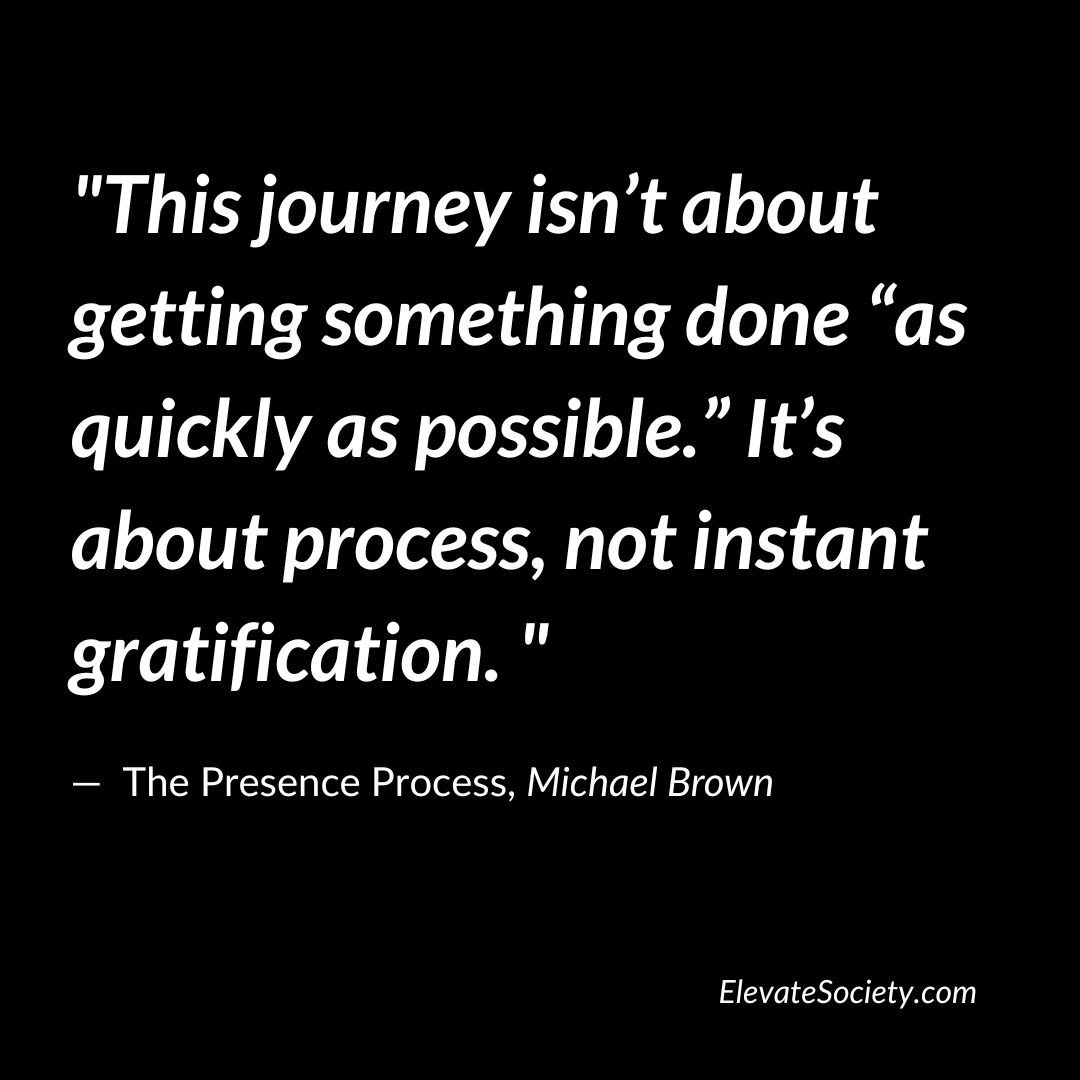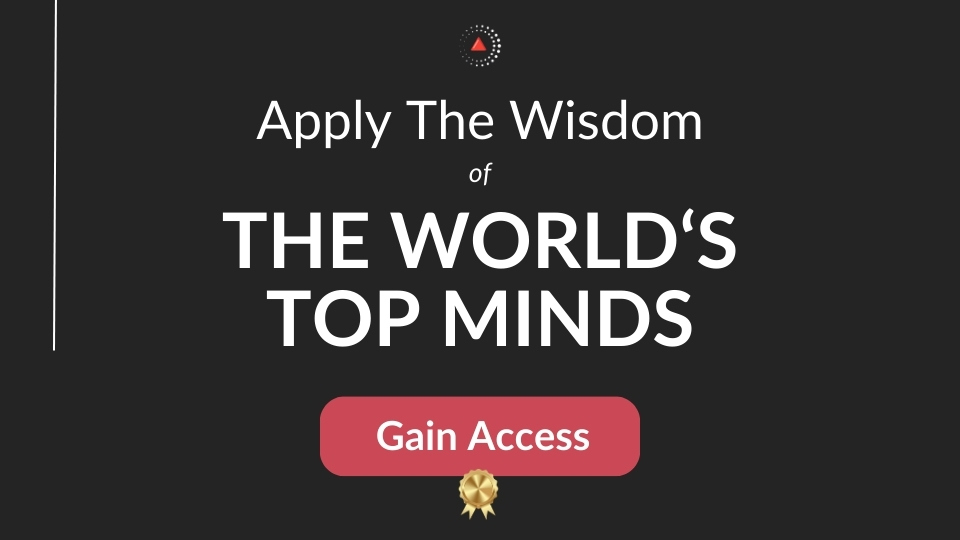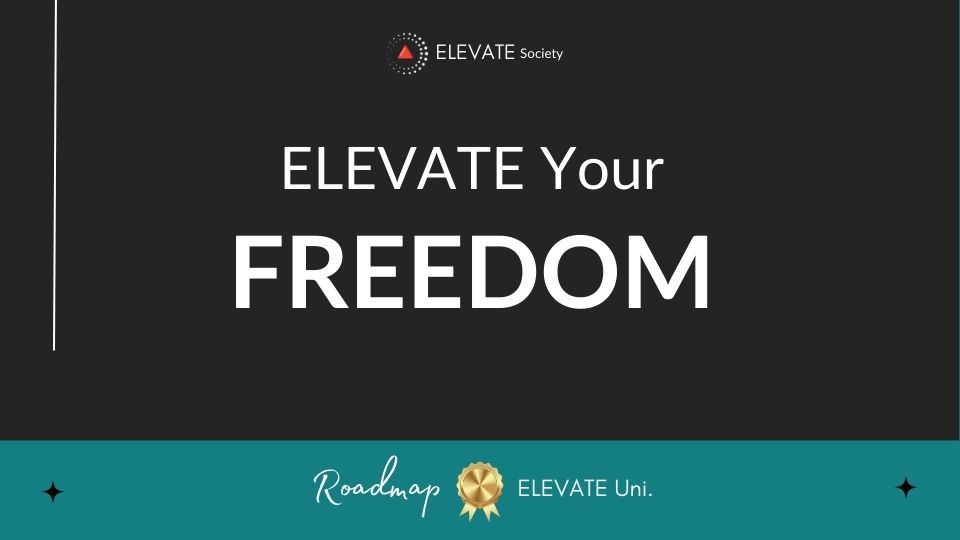The Presence Process: Summary Review & Takeaways
This is a summary review of The Presence Process containing key details about the book.
What is The Presence Process About?
The Presence Process is a journey that guides readers into taking responsibility for our emotional integration. It is a way to consciously grow up and become responsible for determining the quality of our personal experience.
The book teaches readers how to exercise authentic personal responsibility in a practical manner and reveals the mechanics that shape the way they feel about their lives. It offers a simple approach to accomplishing and maintaining personal peace in the midst of globally accelerating change, discomfort, conflict, and chaos.
Who is the Author of The Presence Process?
Michael Brown is the author of the three Namaste Publishing Inc. books: The Presence Process, Alchemy of the Heart and Cat Tales for Mariette. They make up a trinity of his exploration into techniques for emotional integration and growth.
What are key takeaways from The Presence Process?
Learning how to better handle negative or uncomfortable emotions isn't about hiding from them or making yourself feel better, taking yourself from sad to happy, but about getting better at feeling.
How we feel about a present experience is a result of past conditioning therefore, any discomfort we feel now is a memory of something painful that happened to us in the past. Many of our emotions get stuck in us from childhood experiences which go onto distort our view as adults, and if undealt with, can go on to cause health issues.
Knowing that our uncomfortable emotions are a reflection from the past allows us to stop identifying with them. Treat the feelings as messages from the past, temporary experiences that you usually don't allow yourself to look into but that keep reoccurring until you acknowledge the event that caused them.
Your pain and suffering will lessen every time you bring awareness to your present situation so experience the emotions simply by paying attention to them but without judgment or resistance.
Takeaway #2 You Are Responsible For Your Life Experience
Whatever has happened to you is not your fault but it is up to you to choose how you deal with the cards life has played you. Responding rather than reacting is a principle lesson to grasp in the Presence Process and will help you to stop blaming yourself and others.
Reacting means you unconsciously act out based on past patterns. We react in moments of emotional discomfort usually to defend ourselves or to attack another.
Responding means you are consciously aware (responsible) for your emotional state and chose to behave based on what is happening in the present moment instead of projecting your emotions on someone else.
The Presence Process helps you to understand that each and every person or situation that causes you to react is an opportunity to understand and heal. The people who cause us to react defensively or attack are actually showing us our hidden pain, giving us the opportunity to realize it, feel it, and ultimately heal from it.
Takeaway #3 Being Present Is The Greatest Service We Can Do For Ourselves and Humanity
With so many self-improvement products on the market, it can be hard to know where to start on the road to becoming the best version of yourself. But if you start by being present aka mindful, having an awareness of what's going on in the here and now, positive change will follow in all aspects of your life as well as in the lives of those around you.
Book details
- Print length: 325 Pages
- Audiobook: 11 hrs and 5 mins
- Genre: Spirituality, Nonfiction, Self Help, Personal Development, Psychology
What are the chapters in The Presence Process?
Chapter One - What is the Present Moment Awareness?
Chapter Two - The Heartbeat of Reinforcement
Chapter Three - Aligning Intent
Chapter Four - Mechanics of the Process
Chapter Five - Consciousness of Questions
Chapter Six - Movement Beyond Motion
Chapter Seven - The Pathway of Awareness and Seven-Year Cycle
Chapter Eight - Emotional Imprinting
Chapter Nine - Emotional Charge
Chapter Ten - Beyond Addiction and Affliction
Chapter Eleven - Trading Results of Consequences
Chapter Twelve - The Process Trinity
Chapter Thirteen - An Integrative Approach
Chapter Fourteen - Level of Entry
Chapter Fifteen - Navigational Guidance
Chapter Sixteen - Insight and Felt-Perception
Chapter Seventeen - Activation and Maintenance
Chapter Eighteen - The Consciously Connected Breathing Practice
Chapter Nineteen - Into Breath
Chapter Twenty - Presence and Individual Expression
Chapter Twenty-One - Onward, Inward, and Upward
Chapter Twenty-Two - Identifying Messengers
Chapter Twenty-Three - Receiving Insight
Chapter Twenty-Four - Feeling Unconditionally Integrates
Chapter Twenty-Five - Ingregrating Our Childhood
Chapter Twenty-Six - Integration of the Child Self
Chapter Twenty-Seven - Integrating Charged Emotion
Chapter Twenty-Eight - The Mechanics of Reactivity
Chapter Twenty-Nine - The Emotional Integration Procedure
Chapter Thirty - Into the Water
Chapter Thirty-One - Embracing Physical Presence
Chapter Thirty-Two - Feeling Our Way Through
Chapter Thirty-Three - Peace is a Vibration We Feel
Chapter Thirty-Four - Realizing Peace Through Forgiveness
Chapter Thirty-Five - Praying for Forgiveness
Chapter Thirty-Six - Integrating Our Unconscious Definition of Love
Chapter Thirty-Seven - Manipulation
Chapter Thirty-Eight - Giving Unconditionally Is Receiving
Chapter Thirty-Nine – Consciously Entering the Unified Field
Chapter Forty - Living on Purpose
Chapter Forty-One - Appreciating Appreciation
Chapter Forty-Two - Where There's a Gardener, There's a Garden
Chapter Forty-Three - Fruits and Flowers
Chapter Forty-Four - Radiating Present Moment Awareness Responsibly
Chapter Forty-Five - The Story of Clive and Nadine
Chapter Forty-Six - The Organic Unfolding of Present Moment Awareness
Chapter Forty-Seven - Freedom is Responsibility
What are some of the main summary points from the book?
Here are some key summary points from the book:
- The Power of Presence: The book emphasizes the importance of being fully present in each moment, rather than being caught up in regrets of the past or worries about the future. By practicing presence, one can cultivate a deeper sense of awareness and clarity.
- Emotional Healing: The book explores the idea that unresolved emotional pain and trauma from the past can continue to affect our lives in the present. By consciously and compassionately experiencing these emotions, rather than repressing or avoiding them, we can facilitate healing and integration.
- The Practice of Emotional Integration: The author outlines a specific process called "The Presence Process" that involves a 10-week program of self-inquiry and emotional integration. This process is designed to help individuals uncover and release unconscious patterns and beliefs that may be limiting their well-being.
- Conscious Breathing: The book emphasizes the role of conscious breathing as a tool for staying present and navigating challenging emotions. By bringing awareness to the breath, one can ground themselves in the present moment and create space for emotional integration.
- Taking Responsibility: The book encourages individuals to take full responsibility for their emotional states and life experiences. By recognizing that we have the power to choose how we respond to situations, we can reclaim our personal power and create positive change.
- Cultivating Inner Stillness: The practice of meditation and cultivating inner stillness is discussed as a means to deepen presence, connect with our true essence, and experience greater peace and well-being.
The Presence Process Summary Notes
Here are some quick summary notes from first five chapters of the book:
Chapter One Summary - What is the Present Moment Awareness?
Synopsis: The main theme of Chapter One is that present moment awareness is a powerful tool for personal growth and transformation. By learning to be fully present in the moment, we can access deeper levels of consciousness and begin to cultivate a more authentic and fulfilling experience of life.
Summary: Chapter One of "The Presence Process" focuses on the concept of present-moment awareness, which is a fundamental aspect of the author's approach to personal growth and emotional healing. The main theme of this chapter is that living in the present moment is the key to accessing the deeper levels of consciousness that are necessary for lasting transformation.
The author begins by pointing out that most people are not fully present at the moment, but are instead distracted by their thoughts, memories, and worries about the future. This state of mind prevents us from experiencing the fullness of life and can lead to a sense of disconnection and dissatisfaction. The author argues that by cultivating present-moment awareness, we can break free from this cycle and begin to access a deeper level of consciousness that is more aligned with our true nature.
To cultivate present-moment awareness, the author suggests a simple practice of paying attention to our breath and bodily sensations. By focusing on the physical sensations of our body, we can anchor our awareness in the present moment and begin to notice the thoughts and emotions that arise within us. This awareness allows us to observe our patterns of reactivity and begin to disidentify from them, creating space for new insights and perspectives to emerge.

The author also emphasizes the importance of approaching this practice with a spirit of curiosity and openness, rather than trying to achieve a specific goal or outcome. By letting go of our attachment to results and embracing the present moment as it is, we can create a foundation of trust and safety that allows us to explore our inner world with greater depth and clarity.
Chapter Two Summary - The Heartbeat of Reinforcement
Synopsis: Chapter Two of "The Presence Process" focuses on the concept of "The Heartbeat of Reinforcement" and how it affects our present moment awareness. The author, Michael Brown, believes that our lives are governed by an underlying rhythm that can either reinforce negative patterns or create positive change. He calls this rhythm "The Heartbeat of Reinforcement.
Summary: According to Brown, this rhythm is set in motion from a very young age and is shaped by our experiences, thoughts, and emotions. It creates a feedback loop that reinforces our behaviors and beliefs, either positively or negatively. For example, if we have a negative experience, our thoughts and emotions will align with that experience and create a negative pattern that we will continue to reinforce.
The key to breaking this negative pattern is to become aware of this rhythm and consciously interrupt it. This is where "The Presence Process" comes in - by bringing our attention to the present moment, we can break the cycle of negative reinforcement and begin to create positive change in our lives.
Brown explains that our present moment awareness is the key to interrupting this rhythm. When we are fully present, we can observe our thoughts, emotions, and behaviors without getting caught up in them. This allows us to make conscious choices about how we respond to situations, rather than simply reacting based on our past experiences.
Brown offers several techniques for developing present-moment awareness, including breathwork, meditation, and body awareness exercises. By practicing these techniques regularly, we can become more attuned to the underlying rhythm of our lives and consciously interrupt the negative patterns that have been reinforced over time.
In essence, "The Heartbeat of Reinforcement" is a powerful concept that highlights the importance of present moment awareness in creating positive change in our lives. By becoming aware of this rhythm and interrupting negative patterns, we can take control of our lives and begin to create a more fulfilling and meaningful existence.
Chapter Three Summary - Aligning Intent
Synopsis: Chapter Three of "The Presence Process" by Michael Brown is titled "Aligning Intent." In this chapter, Brown emphasizes the importance of setting a clear and focused intention for undertaking the presence process. He asserts that aligning our intent is crucial for the success of the process, as it determines the direction and outcome of our journey.
Summary: Brown argues that we often set intentions that are vague or based on external factors, such as societal expectations, instead of our own desires and needs. He urges readers to take the time to reflect on their true intentions and identify what they want to achieve through the presence process. By aligning our intent with our authentic self, we can create a clear and powerful vision for our journey towards presence.
The author suggests that setting an intention is not enough, and we must continuously align our thoughts, words, and actions with our intention. He stresses that the more aligned we are, the more powerful and effective our intention becomes. Brown uses the analogy of a compass to explain the importance of aligning our intent. Just as a compass points towards a specific direction, our aligned intent serves as a guide that directs us towards our desired outcome.
To help readers align their intent, Brown offers several exercises, including writing a personal mission statement, creating a vision board, and visualizing a future where our intention is realized. He emphasizes that the process of aligning our intent is ongoing and requires continuous effort and reflection.
The main theme of Chapter Three is the importance of aligning our intent with our authentic self and continuously directing our thoughts, words, and actions towards our intention. Through this alignment, we can create a clear and powerful vision for our journey towards presence and ultimately achieve our desired outcome.
Chapter Four Summary - Mechanics of the Process
Synopsis: Chapter Four of "The Presence Process" provides readers with a practical understanding of the mechanics behind the Presence Process. Brown stresses the importance of taking the process step by step and being present in the moment. By doing so, we can become aware of our unresolved emotional charges, integrate them, and ultimately achieve a greater sense of inner peace and well-being.
Summary: Chapter Four of "The Presence Process" by Michael Brown is titled "Mechanics of the Process," and it dives into the specifics of the steps involved in the Presence Process. The main theme of this chapter is to provide readers with a practical understanding of the mechanics behind the Presence Process and to offer guidance on how to move through the process effectively.
Brown begins by reiterating the importance of the Presence Process and how it helps us to integrate the unresolved emotional charges from our past experiences. He stresses that the process is not just about getting rid of negative emotions, but it's about becoming aware of and integrating all of our emotional charges, both positive and negative.
The author then goes on to explain that the Presence Process involves two phases: the inhalation phase and the exhalation phase. During the inhalation phase, we focus on becoming aware of our unresolved emotional charges, while the exhalation phase is all about integrating those emotional charges into our being. The author emphasizes the importance of taking these steps in order and not jumping ahead or skipping any steps, as this can lead to the process being ineffective.
Brown also discusses the importance of being present in the moment and practicing mindfulness throughout the process. He suggests that we should not judge or analyze our emotions but rather observe them and allow them to be. By doing so, we can start to become aware of the emotional charges that we are carrying with us and begin to release them.
The author also highlights the importance of self-nurturing during the Presence Process, encouraging readers to take care of themselves both physically and emotionally. He notes that it's common to experience physical and emotional discomfort during the process, but this discomfort is a natural part of the integration process.
Chapter Five Summary - Consciousness of Questions
Synopsis: Chapter Five of "The Presence Process" highlights the power of conscious questioning to bring awareness and transformation to our patterns of thought and behavior. By becoming aware of the questions we're asking ourselves and consciously shifting them to more empowering ones, we can break free from limiting beliefs and create the life we desire.
Summary: Chapter Five of "The Presence Process" by Michael Brown explores the power of conscious questioning to bring awareness to our patterns of thought and behavior. The author suggests that our minds are constantly asking and answering questions, many of which are subconscious, and these questions shape our reality.
According to Brown, we often ask disempowering questions, such as "Why does this always happen to me?" or "What's wrong with me?" These questions lead us down a negative spiral of thoughts and emotions, which reinforce our limiting beliefs and keep us stuck in old patterns.
To break free from these patterns, Brown encourages us to become aware of the questions we're asking ourselves and to consciously shift them to more empowering ones. He suggests asking questions that focus on solutions rather than problems, such as "How can I create more joy in my life?" or "What can I learn from this situation?"
By asking these kinds of questions, we can reprogram our minds to focus on what we want to create in our lives, rather than what we want to avoid. This shift in focus allows us to tap into our creativity and problem-solving abilities, and to take action towards creating the life we desire.
The author also emphasizes the importance of asking questions without judgment or attachment to the outcome. We should ask questions from a place of curiosity and openness, and be willing to receive whatever answers come up, even if they don't match our expectations or preconceived notions.
What are good quotes from The Presence Process?
 [Favorite Quote]: "This journey isn’t about getting something done “as quickly as possible.” It’s about process, not instant gratification" (Meaning)
[Favorite Quote]: "This journey isn’t about getting something done “as quickly as possible.” It’s about process, not instant gratification" (Meaning)
"We mistakenly spend our experience trying to get something instead of simply receiving that which is already and eternally given."
― Michael Brown - The Presence Process Quotes
* The summary points above have been concluded from the book and other public sources. The editor of this summary review made every effort to maintain information accuracy, including any published quotes, chapters, or takeaways
Chief Editor
 Tal Gur is an author, founder, and impact-driven entrepreneur at heart. After trading his daily grind for a life of his own daring design, he spent a decade pursuing 100 major life goals around the globe. His journey and most recent book, The Art of Fully Living, has led him to found Elevate Society.
Tal Gur is an author, founder, and impact-driven entrepreneur at heart. After trading his daily grind for a life of his own daring design, he spent a decade pursuing 100 major life goals around the globe. His journey and most recent book, The Art of Fully Living, has led him to found Elevate Society.


























